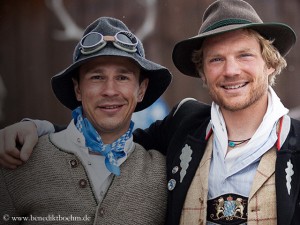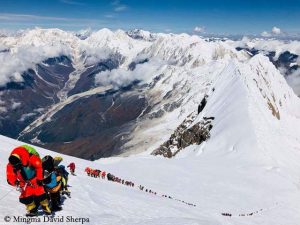Boehm: “The entire slope began to move”
Time is relative, depending on how you feel about it. Already three weeks ago? Only three weeks? This is the length of time that has passed since the avalanche on the eight-thousander Shishapangma in Tibet. On 24 September, the German ski mountaineer Sebastian Haag and the Italian Andrea Zambaldi died in an avalanche that released not far below the summit. Martin Maier, who was also swept away by the masses of snow, survived. Benedikt Boehm and the Swiss Ueli Steck were able to escape the avalanche. I call Benedict at home in Munich.
Benedict, it’s now three weeks since the avalanche on Shishapangma went down. Have you been able to come to terms with the accident?
No, not really. Immediately after the avalanche, I was involved with the rescue of Martin Maier, who had survived the avalanche as if by magic. It took two days, then we headed back home. Now I am busy again in my incredibly wonderful life that I am able to live here. As the manager of a relatively large sports brand, there are many tasks to complete, if you’ve been away for so long. That does not leave much time to come to rest. I had this time only during a couple of hours doing sports in the mountain early in the morning or late in the evening.
Where exactly did the avalanche release?
Almost exactly at 7,900 meters, 100 meters below the summit. We could already see the highest point, it seemed within reach. It was 6.30 a.m., the sun was rising, soon it got warmer, from -30 to -20 degrees Celsius. The mood in the team was great. We had left all key points behind us. We supposed that we would reach the summit all together no later than 8.00 a.m. We tried to climb near the summit ridge. We had left our skis further down, because we had seen that there was too much snow on the slope. Basti made the track, he moved slightly away from the ridge to shorten the way. Basti just turned to me when suddenly the entire slope began to move. It just broke off. There was no bang or something like that. I noticed that I was loosing the ground under my feet. First the snow was moving eerily slow, but then it accelerated suddenly. I could jump to the side because I was close to the ridge. Ueli too, who was just below me. But the other three had no chance to escape.
Martin Maier was – as Basti Haag and Andrea Zambaldi – swept away by the avalanche. How did he succeed in saving himself?
We lost sight of our three friends, because the avalanche slipped down a convex glacier area. We could only see the avalanche again when it stopped about 600 meters below in a trough. It was a huge avalanche that started small, but spread enormously, like an upside down “V”. Martin was incredibly lucky. Possibly it saved his life that he was able to take off his rucksack and throw away his sticks. When the avalanche came to a halt, he was lying on the surface. He was also lucky because he suffered no very severe injuries. He had a head injury, no open wound, a haematoma. He was lying unconscious for seven hours, then he woke up. He found the strength to reach Camp 3, despite a torn ligament in his knee. All in all it is a small miracle that he survived.
He was really swept down 600 meters?
Yes, Martin was lying on the snow at the avalanche cone. First he did not know where he was and what had happened. But then his memory returned. He even looked for Basti and Andrea, but could not find them.
Ueli and you spent hours trying in vain to get into the avalanche zone. Was it impossible to recover the two buried climbers?
We could not climb down the path of the avalanche, it was too steep and too dangerous. My idea was to descend to an altitude of 7,300 meters and to traverse the avalanche slope with skis. Ueli was rightly skeptical because of the avalanche risk. Nevertheless we tried it, but it was cracking everywhere, the slopes were overloaded with snow. At that moment I realized that I had to return. I thought: I have two young sons, and it is no help to anyone if I risk my life. The chance to rescue our buried friends was very, very low. It had taken us about 45 minutes to descent to Camp 3 and we would have needed another hour to reach the avalanche cone. One and three quarter hours, much too long for someone who is buried under a blanket of snow that is as tightly compressed as concrete. Apart from that we had no shovels for digging. Once again we climbed up 100 meters and tried to get across there. But the risk was too great. It would not have been impossible, but very, very dangerous. The Sherpas, who had climbed up to help us, said immediately that they would not enter the dangerous avalanche zone.
At your first summit attempt, you had returned slightly below the later scene of accident due to the great danger of avalanches. Have you also discussed this time, if you should climb on or not?
At our first attempt, the avalanche risk was not the main reason why we turned around. We thought that we were able to control the risk, if we stayed on the ridge. On 18 September, we had just no more energy to climb on. The snow on the ridge was so deep that we sank into it up to our chests.
Before your second attempt, you said that would be definitely your last. Have you set yourself under too much pressure?
It is difficult to know. Pressure is also important. If you are not motivated to the last during such projects at the eight-thousanders, you will not succeed. You need this pressure that pushes you and tells you to do your very best. But of course you also have to keep cool. We have proved this ability, for example in 2012 on Broad Peak, when we returned only 20 meters below the main summit because it was too dangerous.
Ueli and you were really lucky.
Definitely. I was already in Basti’s track, but then I turned around instinctively and walked a few steps out of the slope. Somehow I realized: No, I will not enter this slope. It was an inner decision, consciously or unconsciously, I don’t know.
After the accident, Reinhold Messner criticized you in an interview to have sold your project as a record attempt.
I have always dissociated myself from the word “record” in connection with what I’m doing in the mountains. Records make sense on a 100-meter track, but not on an eight-thousander, where the conditions can change completely from day to day. I have always tried to be fast on the mountain to be safer, not to break any record. In relation to our project “Double8” we never used the term “record” or “world record”. I’ve heard it for the first time after my return. It’s annoying. But you can not blame the media for using these words. If the headline contains the term “world record”, probably eight out of ten Internet users will click on the article, using “Double8” perhaps one.
2012 on Manaslu, Sebastian and you narrowly escaped an avalanche. At that time 11 climbers died. Now you’ve lost Basti, your best friend and climbing partner, in the avalanche on Shishapangma. What does this mean for your future as a professional mountaineer?
I don’t know yet. A companion like Basti is not replaceable. Going to the limits like we do, you need someone whom you can trust blindly, who shares the same values, and who is on the same wavelength. We talked about everything, politics, culture, business, whatever, but not about any mountain stories. We just did not want to be one-sided. I really do not know yet what the future will bring. Anyway, I had tried to reduce the risk by choosing Shishapangma and Cho Oyu for our project. Basti had preferred Dhaulagiri. But I had told him: It’s too dangerous. I will no more ski down such steep faces with incalculable risks. I did it before, but now I have a family.











